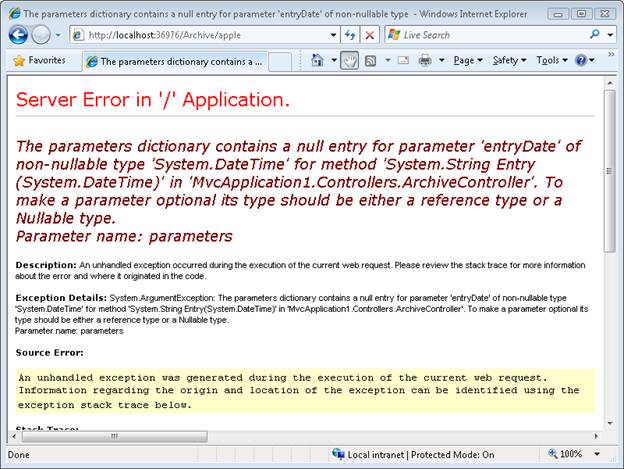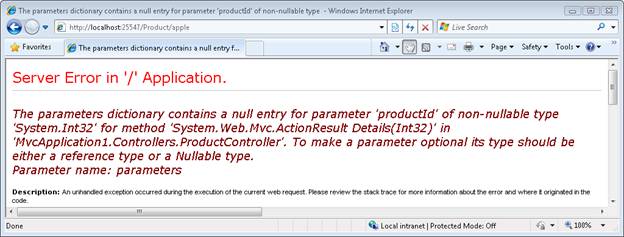ASP.NET MVC- Controllers and Routing- Routing
二、Creating Custom Routes
In this tutorial, you learn how to add a custom route to an ASP.NET MVC application. You learn how to modify the default route table in the Global.asax file with a custom route.
For many simple ASP.NET MVC applications, the default route table will work just fine. However, you might discover that you have specialized routing needs. In that case, you can create a custom route.
Imagine, for example, that you are building a blog application. You might want to handle incoming requests that look like this:
/Archive/12-25-2009
When a user enters this request, you want to return the blog entry that corresponds to the date 12/25/2009. In order to handle this type of request, you need to create a custom route.
The Global.asax file in Listing 1 contains a new custom route, named Blog, which handles requests that look like /Archive/entry date.
Listing 1 - Global.asax (with custom route)
using System.Web.Mvc;
using System.Web.Routing;
namespace MvcApplication1
{
public class MvcApplication : System.Web.HttpApplication
{
public static void RegisterRoutes(RouteCollection routes)
{
routes.IgnoreRoute("{resource}.axd/{*pathInfo}");
routes.MapRoute(
"Blog", // Route name
"Archive/{entryDate}", // URL with parameters
new { controller = "Archive", action = "Entry" } // Parameter defaults
);
routes.MapRoute(
"Default", // Route name
"{controller}/{action}/{id}", // URL with parameters
new { controller = "Home", action = "Index", id = "" } // Parameter defaults
);
}
protected void Application_Start()
{
RegisterRoutes(RouteTable.Routes);
}
}
}
The order of the routes that you add to the route table is important. Our new custom Blog route is added before the existing Default route. If you reversed the order, then the Default route always will get called instead of the custom route.
The custom Blog route matches any request that starts with /Archive/. So, it matches all of the following URLs:
/Archive/12-25-2009
/Archive/10-6-2004
/Archive/apple
The custom route maps the incoming request to a controller named Archive and invokes the Entry() action. When the Entry() method is called, the entry date is passed as a parameter named entryDate.
You can use the Blog custom route with the controller in Listing 2.
Listing 2 - ArchiveController.cs
using System;
using System.Web.Mvc;
namespace MvcApplication1.Controllers
{
public class ArchiveController : Controller
{
public string Entry(DateTime entryDate)
{
return "You requested the entry from " + entryDate.ToString();
}
}
}
Notice that the Entry() method in Listing 2 accepts a parameter of type DateTime. The MVC framework is smart enough to convert the entry date from the URL into a DateTime value automatically. If the entry date parameter from the URL cannot be converted to a DateTime, an error is raised (see Figure 1).
Figure 1 - Error from converting parameter

Summary
The goal of this tutorial was to demonstrate how you can create a custom route. You learned how to add a custom route to the route table in the Global.asax file that represents blog entries. We discussed how to map requests for blog entries to a controller named ArchiveController and a controller action named Entry().
三、Creating a Route Constraint
In this tutorial, Stephen Walther demonstrates how you can control how browser requests match routes by creating route constraints with regular expressions.
You use route constraints to restrict the browser requests that match a particular route. You can use a regular expression to specify a route constraint.
For example, imagine that you have defined the route in Listing 1 in your Global.asax file.
Listing 1 - Global.asax.cs
routes.MapRoute(
"Product",
"Product/{productId}",
new {controller="Product", action="Details"}
);
Listing 1 contains a route named Product.
You can use the Product route to map browser requests to the ProductController contained in Listing 2.
Listing 2 - Controllers\ProductController.cs
using System.Web.Mvc;
namespace MvcApplication1.Controllers
{
public class ProductController : Controller
{
public ActionResult Details(int productId)
{
return View();
}
}
}
Notice that the Details() action exposed by the Product controller accepts a single parameter named productId. This parameter is an integer parameter.
The route defined in Listing 1 will match any of the following URLs:
- /Product/23
- /Product/7
Unfortunately, the route will also match the following URLs:
- /Product/blah
- /Product/apple
Because the Details() action expects an integer parameter, making a request that contains something other than an integer value will cause an error. For example, if you type the URL /Product/apple into your browser then you will get the error page in Figure 1.

What you really want to do is only match URLs that contain a proper integer productId. You can use a constraint when defining a route to restrict the URLs that match the route. The modified Product route in Listing 3 contains a regular expression constraint that only matches integers.
Listing 3 - Global.asax.cs
routes.MapRoute(
"Product",
"Product/{productId}",
new {controller="Product", action="Details"},
new {productId = @"\d+" }
);
The regular expression \d+ matches one or more integers. This constraint causes the Product route to match the following URLs:
- /Product/3
- /Product/8999
But not the following URLs:
- /Product/apple
- /Product
These browser requests will be handled by another route or, if there are no matching routes, a The resource could not be found error will be returned.
四、Creating a Custom Route Constraint
Stephen Walther demonstrates how you can create a custom route constraint. We implement a simple custom constraint that prevents a route from being matched when a browser request is made from a remote computer.
The goal of this tutorial is to demonstrate how you can create a custom route constraint. A custom route constraint enables you to prevent a route from being matched unless some custom condition is matched.
In this tutorial, we create a Localhost route constraint. The Localhost route constraint only matches requests made from the local computer. Remote requests from across the Internet are not matched.
You implement a custom route constraint by implementing the IRouteConstraint interface. This is an extremely simple interface which describes a single method:
bool Match(
HttpContextBase httpContext,
Route route,
string parameterName,
RouteValueDictionary values,
RouteDirection routeDirection
)
The method returns a Boolean value. If you return false, the route associated with the constraint won’t match the browser request.The Localhost constraint is contained in Listing 1.
Listing 1 - LocalhostConstraint.cs
using System.Web;
using System.Web.Routing;
namespace MvcApplication1.Constraints
{
public class LocalhostConstraint : IRouteConstraint
{
public bool Match
(
HttpContextBase httpContext,
Route route,
string parameterName,
RouteValueDictionary values,
RouteDirection routeDirection
)
{
return httpContext.Request.IsLocal;
}
}
}
The constraint in Listing 1 takes advantage of the IsLocal property exposed by the HttpRequest class. This property returns true when the IP address of the request is either 127.0.0.1 or when the IP of the request is the same as the server’s IP address.
You use a custom constraint within a route defined in the Global.asax file. The Global.asax file in Listing 2 uses the Localhost constraint to prevent anyone from requesting an Admin page unless they make the request from the local server. For example, a request for /Admin/DeleteAll will fail when made from a remote server.
Listing 2 - Global.asax
using System;
using System.Collections.Generic;
using System.Linq;
using System.Web;
using System.Web.Mvc;
using System.Web.Routing;
using MvcApplication1.Constraints;
namespace MvcApplication1
{
public class MvcApplication : System.Web.HttpApplication
{
public static void RegisterRoutes(RouteCollection routes)
{
routes.IgnoreRoute("{resource}.axd/{*pathInfo}");
routes.MapRoute(
"Admin",
"Admin/{action}",
new {controller="Admin"},
new {isLocal=new LocalhostConstraint()}
);
//routes.MapRoute(
// "Default", // Route name
// "{controller}/{action}/{id}", // URL with parameters
// new { controller = "Home", action = "Index", id = "" } // Parameter defaults
//);
}
protected void Application_Start()
{
RegisterRoutes(RouteTable.Routes);
}
}
}
The Localhost constraint is used in the definition of the Admin route. This route won’t be matched by a remote browser request. Realize, however, that other routes defined in Global.asax might match the same request. It is important to understand that a constraint prevents a particular route from matching a request and not all routes defined in the Global.asax file.
Notice that the Default route has been commented out from the Global.asax file in Listing 2. If you include the Default route, then the Default route would match requests for the Admin controller. In that case, remote users could still invoke actions of the Admin controller even though their requests wouldn’t match the Admin route.
原文:http://www.asp.net/mvc/tutorials/controllers-and-routing/asp-net-mvc-controller-overview-vb
译文:http://www.cnblogs.com/JimmyZhang/archive/2009/03/08/1406512.html
ASP.NET MVC- Controllers and Routing- Routing的更多相关文章
- Post Complex JavaScript Objects to ASP.NET MVC Controllers
http://www.nickriggs.com/posts/post-complex-javascript-objects-to-asp-net-mvc-controllers/ Post ...
- Asp.Net MVC 3【URLs, Routing,and Areas】续
http://www.cnblogs.com/HuiTai/archive/2012/07/24/2597875.html 接着前面继续学习分享我们的路由. 现在我们把Global.asax文件里的R ...
- ASP.NET MVC 入门3、Routing
本系列文章基于Microsoft ASP.NET MVC Beta. 在一个route中,通过在大括号中放一个占位符来定义( { and } ).当解析URL的时候,符号"/"和& ...
- [转]ASP.NET MVC 入门3、Routing
在一个route中,通过在大括号中放一个占位符来定义( { and } ).当解析URL的时候,符号"/"和"."被作为一个定义符来解析,而定义符之间的值则匹配 ...
- ASP.NET MVC Controllers and Actions
MVC应用程序里的URL请求是通过控制器Controller处理的,不管是请求视图页面的GET请求,还是传递数据到服务端处理的Post请求都是通过Controller来处理的,先看一个简单的Contr ...
- Asp.net MVC十问十答[译]
1. Explain MVC (Model-View-Controller) in general? MVC (Model-View-Controller) is an architectural s ...
- [引]ASP.NET MVC 4 Content Map
本文转自:http://msdn.microsoft.com/en-us/library/gg416514(v=vs.108).aspx The Model-View-Controller (MVC) ...
- 【转】ASP.NET MVC教程
转自:http://www.cnblogs.com/QLeelulu/category/123326.html ASP.NET MVC的最佳实践与性能优化的文章 摘要: 就一些文章链接,就不多废话了. ...
- ASP.NET MVC HttpVerbs.Delete/Put Routes not firing
原文地址: https://weblog.west-wind.com/posts/2015/Apr/09/ASPNET-MVC-HttpVerbsDeletePut-Routes-not-firing ...
- 自学MVC看这里——全网最全ASP.NET MVC 教程汇总
MVC架构已深得人心,微软也不甘落后,推出了Asp.net MVC.小编特意整理博客园乃至整个网络最具价值的MVC技术原创文章,为想要学习ASP.NET MVC技术的学习者提供一个整合学习入口.本文从 ...
随机推荐
- php Static静态关键字
静态属性与方法可以在不实例化类的情况下调用,直接使用类名::方法名的方式进行调用.静态属性不允许对象使用->操作符调用. class Car { private static $speed = ...
- MVVM Light 一个窗口承载两个视图
MVVM Light 一个窗口承载两个视图 原文地址:http://www.codeproject.com/Articles/323187/MVVMLight-Using-Two-Views 本文 ...
- 编程书籍分享--pdf
作为程序员,我觉得我们应该多学习.多思考.多分享. 今天就花费了一点时间把这几年搜集的编程资料上传到了网上做个分享, 其中涵盖.net .java.js.html5.css3.mysql.sqlser ...
- bootstrap table 服务器分页
1.封装MODEL using System;using System.Collections.Generic;using System.Linq;using System.Text;using Sy ...
- MIME
http://www1.huachu.com.cn/read/readbookinfo.asp?sectionid=1000000558 http://www.jb51.net/hack/10623. ...
- ECmall错误:Call to a member function get_users_count() on a non-object
问题描述: 在后台添加了一个app报错:Call to a member function get_users_count()Fatal error: Call to a member functio ...
- php 文件上传 以及保存在本地的乱码问题处理
要知道两点: ①浏览器传到PHP程序中是UTF-8编码 ②PHP程序保存上传的文件,要转换成GBK编码才保存在本地中,否则如果直接使用浏览器传过来的文件名保存在本地,会出现文件名乱码. <?ph ...
- xbmc
XBMC是一个优秀的自由和开源的(GPL)媒体中心软件.XBMC最初为Xbox而开发,可以运行在Linux.OSX.Windows.Android4.0系统.XBMC能够播放几乎所有流行的音频和视频格 ...
- USB OTG
OTG检测的原理是:USB OTG标准在完全兼容USB2.0标准的基础上,增添了电源管理(节省功耗)功能,它允许设备既可作为主机,也可作为外设操作(两用OTG).USB OTG技术可实现没有主机时设备 ...
- 【Xamarin开发 Android 系列 3】循序渐进的学习顺序
原文:[Xamarin开发 Android 系列 3]循序渐进的学习顺序 指定合理的学习步骤,将各个技术点进行强化.慢慢 的就从点到线 到面的飞跃,一切仅仅是时间问题,开始前,请记住,学习是最佳的投资 ...
